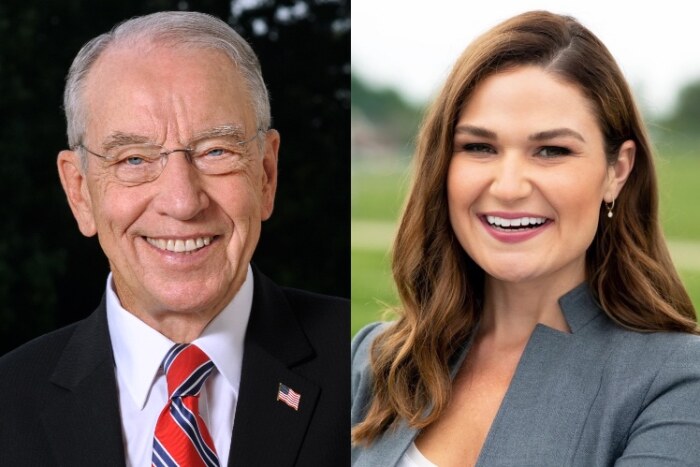The latest Federal Election Commission filings from Iowa’s U.S. Senate candidates included one big surprise. Former U.S. Representative Abby Finkenauer raised more money than seven-term Senator Chuck Grassley during the third quarter of the year.
Follow me after the jump for highlights on fundraising and spending by all the Senate candidates.
DEMOCRATS: ABBY FINKENAUER, DAVE MUHLBAUER, GLENN HURST
Usually I start with the incumbent’s FEC filing, but this quarter the big news was on the Democratic side. I was expecting a large number from Finkenauer, whose 2020 campaign for U.S. House raised about $5.9 million. But it’s easier to raise money as a member of Congress seeking re-election than as a challenger to an Iowa institution.
Finkenauer’s campaign reported $1,000,285.57 in contributions from late July, when she announced her Senate candidacy, through September 30. The vast majority of funds ($968,985.57) came from individuals. Unitemized contributions from people who gave than $200 accounted for $440,504.93, pointing to a very large number of small donors.
According to an October 6 news release from the campaign, more than 15,900 unique donors gave to Finkenauer during the third quarter, including individuals from all 99 Iowa counties. Although dozens of donors did max out with gifts of $2,900 or $5,800, the campaign says 99 percent of those who have supported Finkenauer financially can contribute again.
A dozen political action committees associated with Democrats, labor unions, or progressive organizations chipped in a total of $31,300, including $5,800 from the SPARK PAC, Finkenauer’s own leadership PAC. The candidate also transferred $20,000 from her past Congressional campaign fund to the Senate account.
The campaign’s burn rate was high, with $422,051.30 in total 3Q disbursements from July through September and $419,194.35 in operating costs. Digital advertising alone accounted for $173,515. Other large expenses included various kinds of consulting, staff salaries, texting services, and media production. Some of those costs may represent one-time needs, but most will be ongoing, at least through the June 2022 primary.
As of September 30, Finkenauer’s campaign had $598,350.92 cash on hand. That’s a lot of ground for Mike Franken to make up; he announced his candidacy last week and plans to focus on fundraising for the next few months. Having raised about $850,000 for his 2020 Senate bid, he has potential to raise enough for a statewide campaign before the primary.
The other three declared Democratic candidates will likely struggle to raise their name recognition. Dave Muhlbauer, who launched his campaign in May, reported raising $27,209.95 during the third quarter, all from individuals. Most of those contributions came in during July or early August. (Muhlbauer had raised $43,215.09 through June and put $20,000 of his own money into the campaign as well.) After spending $41,284.56 during the third quarter (mostly on digital communications, media production, texting services, and consulting), Muhlbauer’s campaign had $46,033.77 in the bank on September 30.
Glenn Hurst’s first quarterly filing since joining the race in July showed $32,130.70 in total contributions, all from individuals, and just $85.59 in spending, leaving $32,045.11 cash on hand.
Bob Krause announced his candidacy after the 3Q ended, so won’t report on his fundraising and spending until January. He does not appear to have raised any money for his 2016 campaign and raised only about $24,000 for his first Senate bid in 2010.
REPUBLICANS: CHUCK GRASSLEY, JIM CARLIN
Grassley’s campaign reported raising $824,460.95 during the quarter, split four ways. Individuals contributed $263,564.18, the National Republican Senatorial Committee gave $46,500.00, a long list of Republican, corporate, and industry PACs gave $284,100.01, and other GOP fundraising committees transferred $229,675.69 collected from major donors.
A news release from Finkenauer’s campaign last week characterized Grassley’s fundraising as “meager.” But it’s worth noting that the senator didn’t confirm he was seeking an eighth term until the last week of September. On the other hand, Finkenauer raised nearly four times as much from individual donors during the quarter as Grassley did, which is embarrassing for someone who’s been in public office for more than 60 years.
Back to the senator’s FEC filing: his campaign spent $299,293.30 from July through September. The itemized expenditures include $20,000 for polling, about $44,000 for direct mail, and well over $100,000 for various kinds of consulting.
Grassley’s campaign had $3,064,339.02 cash on hand as of September 30.
State Senator Jim Carlin is also competing for the GOP nomination, and at first glance, he had a strong quarter, with $94,204.59 in total contributions. But the candidate himself was responsible for $76,373.59 of that amount. (That’s on top of the $41,200 Carlin loaned his campaign earlier in the year.) Carlin raised just $17,831.00 from individuals from July through September.
Even worse, Carlin’s campaign spent $101,537.30 during the reporting period, mostly on advertising, various kinds of consulting, and staff salaries. That left just $1,487.32 cash on hand.
To top it all off, former President Donald Trump endorsed Grassley in early October, even though Carlin has been running for Senate as the Trump loyalist in the field. Carlin may attract some protest votes in the GOP primary; Grassley’s approval among Iowa Republicans is running a bit below that of Governor Kim Reynolds and Senator Joni Ernst. But there’s no question about who will be the 2022 GOP nominee.


1 Comment
Let's not forget about Admiral Mike Franken
Since he just entered the race last week, he may not have numbers to report. He may be the most qualified of the lot, so I hope people aren’t thinking this race is already determined. That led to a sorry outcome the last time around.
Kevin Gade Wed 20 Oct 5:39 PM